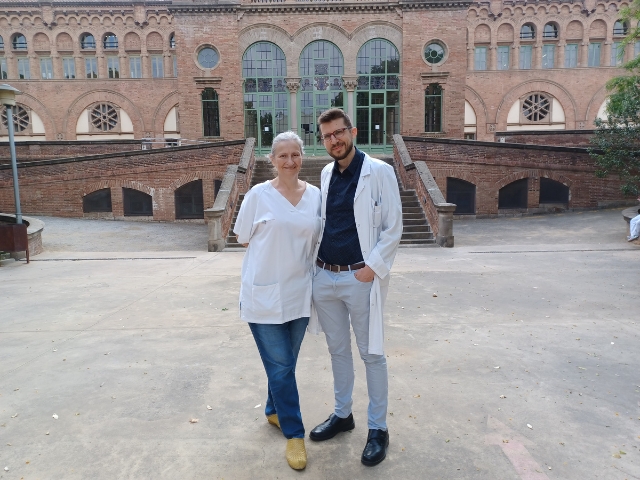
A study conducted by researchers at the Research Institute from Hospital Santa Creu i Sant Pau – IIB Sant Pau in Barcelona, Spain, has shown that deep brain stimulation of the subcallosal cingulate gyrus (SCG-DBS) can offer significant and lasting benefits for treating depression. The results of this research support the idea that this surgical intervention could be an effective alternative for patients suffering from severe major depression who have not responded to conventional treatments.
The study, published today in The Journal of Clinical Psychiatry, is the longest follow-up of patients conducted in Europe to date, analyzing clinical factors related to the long-term benefits and safety of deep brain stimulation of the subcallosal cingulate gyrus in treatment-resistant depression, as explained by Dr Javier de Diego and Dr Dolors Puigdemont, researchers in the Mental Health Research Group at IIB Sant Pau and psychiatrists at the same hospital.
Depression is a disease that ranks among the leading medical causes of disability. It is estimated to affect nearly 300 million people worldwide. Conventional treatments generally yield good results, but it is estimated that 15 to 20% of patients do not respond adequately and show a more chronic and treatment-resistant course. These forms of treatment-resistant depression present a much higher risk of functional disability and have higher rates of complications and even mortality. Moreover, they have a much greater impact on quality of life.
“In these cases, in addition to combining pharmacological treatment with psychotherapy, we have the option of using combination or augmentation strategies with drugs and molecules that act through different mechanisms of action. We can even opt for interventions such as electroconvulsive therapy for the most severe cases. However, there is a small subgroup of more severe patients who either cannot tolerate these treatments or stop responding to these strategies, experiencing recurrences and frequent hospitalizations or a persistent chronic course. In these cases, deep brain stimulation can be a hopeful alternative,” says Dr de Diego.
This study analyzed data from sixteen patients with treatment-resistant major depression, diagnosed according to the criteria of the Diagnostic and Statistical Manual of Mental Disorders (DSM-IV or DSM-5), who received chronic deep brain stimulation of the subcallosal cingulate gyrus for a period of up to 11 years, from January 2008 to June 2019. Demographic, clinical, and overall functioning data were collected before surgery and during follow-up.
One of the most notable aspects, according to the psychiatrist from Sant Pau, is that patients showed sustained clinical improvements after the intervention, as measured by the 17-item Hamilton Depression Rating Scale (HAM-D17), the Clinical Global Impression, and the Global Assessment of Functioning.
The results demonstrate a significant decrease in depressive symptoms over time. As detailed by Dr de Diego, up to 75% of patients responded to treatment, and 50% ultimately achieved remission, meaning a reduction in symptoms below the threshold considered pathological, although not everyone could achieve complete functional recovery. “The repercussions of severe chronic depression are highly pronounced from a personal, social, and occupational perspective, and in many cases condemn individuals to a limited and isolated life for years,” explains Dr Puigdemont.
“A decrease in the frequency of depressive recurrences or an attenuation of symptom intensity are already very significant milestones for these individuals. In fact, in our sample, 40% of the treated patients achieved satisfactory levels of functional recovery, allowing them to enjoy their leisure time or engage in social and family life again, in some cases as they did before the onset of the illness,” explains the expert.
The effects are not immediate but are usually perceived within the first few months. Specifically, 55% of patients achieved remission an average of 139 days after the surgical intervention, according to the experts from Sant Pau.
In conclusion, deep brain stimulation of the subcallosal cingulate gyrus produced significant and lasting improvement in the majority of the patients studied, reinforcing the possibility that this technique may be an alternative for those suffering from treatment-resistant major depression when all other alternatives have been exhausted. “One of the current challenges is to identify clinical and neurobiological predictors of response in order to anticipate which cases of depression could benefit the most and determine the most appropriate parameters for deep brain stimulation in a more early and precise manner,” says Dr de Diego.
Deep brain stimulation is a technique that involves the implantation of ultra-thin electrodes in the brain, connected to small wires that run under the skin and reach a neurostimulator—similar to a pacemaker—that is usually placed in the pectoral or abdominal region. This neurostimulator generates electrical impulses whose parameters can be modified using an external controller until the desired response is observed. “The subcallosal cingulate cortex is a key brain region in depression. Evidence suggests that modulating the electrical activity in this region through deep stimulation can restore the functioning of brain circuits that are crucial in the persistence of these more severe and treatment-resistant depressive episodes,” explains Dr de Diego.
“The placement of the electrodes requires a thorough prior neuroimaging study and a surgical intervention that requires high precision and complexity, so multidisciplinary work between psychiatrists and neurosurgeons is essential. Subsequently, especially during the early post-intervention stage, it is necessary to closely monitor these patients, who require a comprehensive pharmacological, psychotherapeutic, and rehabilitative intervention plan,” reminds Dr Puigdemont.
In this study, researchers from the Mental Health Research Group at IIB Sant Pau, led by Dr Maria Portella, and several professionals from the Psychiatry Department of the same hospital, directed by Dr Narcís Cardoner, have worked closely with neurosurgeons Dr Rodrigo Rodríguez-Rodríguez and Dr Juan A. Aibar-Durán to provide this therapeutic alternative aimed at patients with the most severe affective disorders.
Last update: 29 de June de 2023